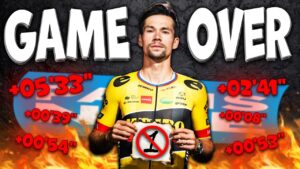How La Vuelta Became The MESSIEST And Most DRAMATIC Grand Tour with Watts
Source: Watts Youtube Channel: How La Vuelta Became The MESSIEST And Most DRAMATIC Grand Tour
Video How La Vuelta Became The MESSIEST And Most DRAMATIC Grand Tour with Watts Youtube Channel
Video How La Vuelta Became The MESSIEST And Most DRAMATIC Grand Tour with Watts YouTube Channel.
How La Vuelta Became The MESSIEST And Most DRAMATIC Grand Tour | Watts
Watts Youtube Channel: The Unconventional Rise of La Vuelta
La Vuelta a España, commonly known as La Vuelta, is one of the three grand Tours in the cycling world, and it has a special taste to it unlike any other. The race has gained a reputation for its unpredictability, unconventionality, and most importantly, the feeling that you’re watching one hell of a bike race. In this article, we will dive into the unconventional rise of La Vuelta, exploring its history, challenges, and triumphs. We will uncover how the race transformed from a Spain-focused event to a global sensation and how it continues to captivate both riders and spectators alike.
The Early Days: A Spain-Focused Race
Before the year 1995, La Vuelta was mainly an event held for Spanish riders and teams. It was primarily seen as a race for the Spanish to dominate, and they did just that. The race had a heavy Spanish accent in the 1970s and 1980s, with Spanish teams ganging up on intruders from other nations and leaving no question of who was winning the race. This exclusivity made it hard for non-Spanish teams to view La Vuelta as a race to tackle. The race’s Spanish dominance was further solidified when the entire Spanish peloton prevented a British rider, Robert Miller, from winning, sending a clear message that La Vuelta es nuestro – the Vuelta is ours.
Challenges and Controversies: The Crisis of La Vuelta
La Vuelta faced a series of challenges that hindered its growth and global appeal. Many editions of the race hardly lasted two weeks, and the mountain stages were close to non-existent. Inadequate infrastructure and logistical issues plagued the race, making it hard for it to be seen on the level of the Tour de France or the Giro. Additionally, by the late 1990s and early 2000s, the race had become somewhat of a paid holiday for big-name cycling stars, as riders and teams indulged in nightly celebrations of sponsor parties, often leading to controversial incidents and bans.
The Turning Point: Javier Guillén and ASO Takeover
In 2008, Javier Guillén took over as the head of La Vuelta and faced significant challenges, including Spain’s economic downturn. The country’s financial instability had severe repercussions for the cycling industry, leading to a drastic reduction in pro teams and funding. However, Guillén didn’t give up on La Vuelta. He understood that cycling races are a business, and he began pitching the race to numerous sponsors and government bodies, offering them a platform to promote their tourist destinations. Moreover, Guillén found a way to redefine the race’s character, moving it from the big flat roads into the heart of Spain, turning it into a tourist trip for both the riders and the spectators.
The Magical Formula: Polishing La Vuelta
Guillén’s vision for La Vuelta was clear: shorter stages, lots of climbs, and a GC battle that would go down to the wire. He transformed the race into a spectacle, making every stage a mini-movie and attracting the world’s top GC riders. Through careful planning and selection of host cities, Guillén turned the race into a global sensation. His meticulous attention to detail and desire to make the race unfold like a soccer match coming down to penalty kicks paid off as the race drew in top riders and captivated audiences worldwide.
New Challenges: The Evolution of La Vuelta
As La Vuelta evolved with shorter, more demanding stages, it also faced new challenges. The race became increasingly demanding for riders, leading to the absence of sprinters and a shift in the dynamics of the competition. However, despite the controversies and changes, top riders continued to be drawn to La Vuelta, with the race finding the right amount of difficulty and maintaining a free-spirited attitude that captured the essence of Spain’s laid-back vibe.
The Allure of La Vuelta: An Unpredictable and Exciting Race
Despite the greater commercial success and global appeal, La Vuelta retains its unpredictable nature, making it an exciting and unique event in the cycling calendar. The race’s ability to keep viewers and riders guessing until the very end is what sets it apart from other grand tours. La Vuelta is special in its own way, offering an experience that transcends the traditional intensity of other races, and its enigmatic allure continues to captivate both seasoned cyclists and casual fans alike.
Conclusion
La Vuelta has undergone a remarkable transformation from a Spain-focused race struggling with challenges to a global sensation that continues to captivate audiences worldwide. Javier Guillén’s visionary leadership and strategic reforms brought about a new era for the race, solidifying its status among the grand tours while maintaining its distinctive charm. The unconventionality, burstiness, and sheer unpredictability of La Vuelta make it a must-watch event in the cycling world, and its allure continues to grow with each passing year.
The opinions expressed in this space are the sole responsibility of the YouTube Channel Watts and do not necessarily represent the views of CicloNews.










